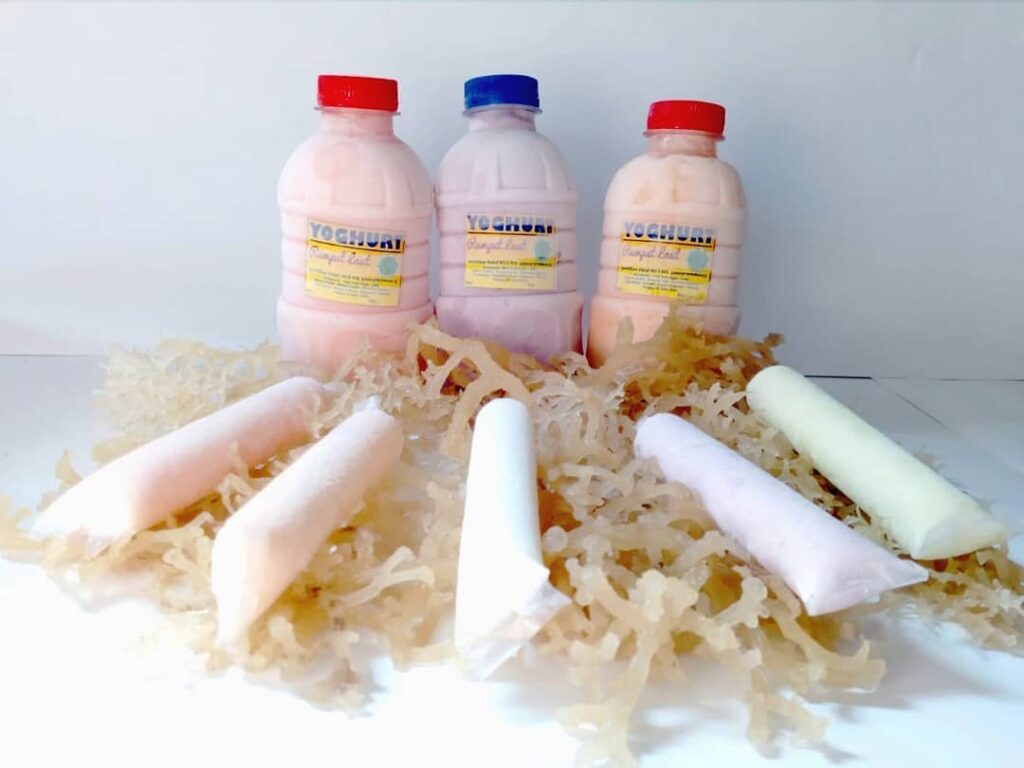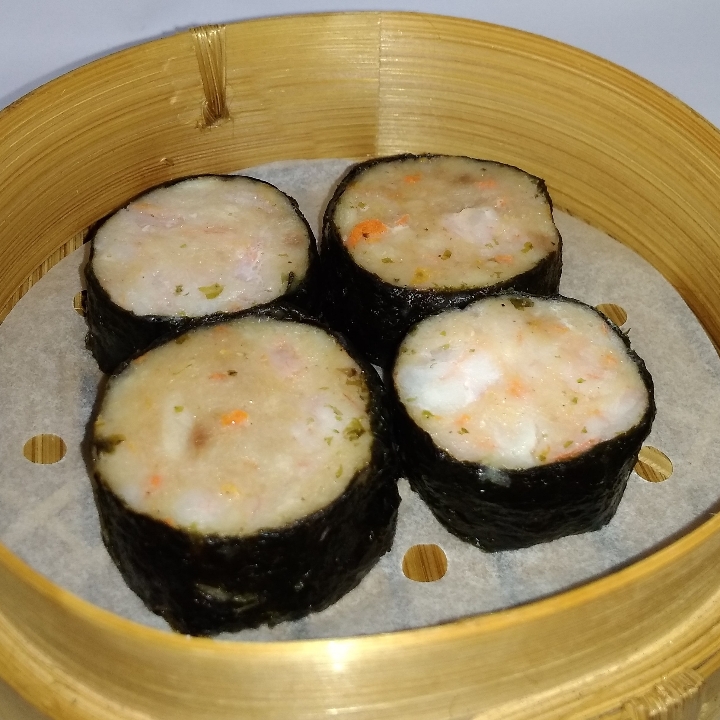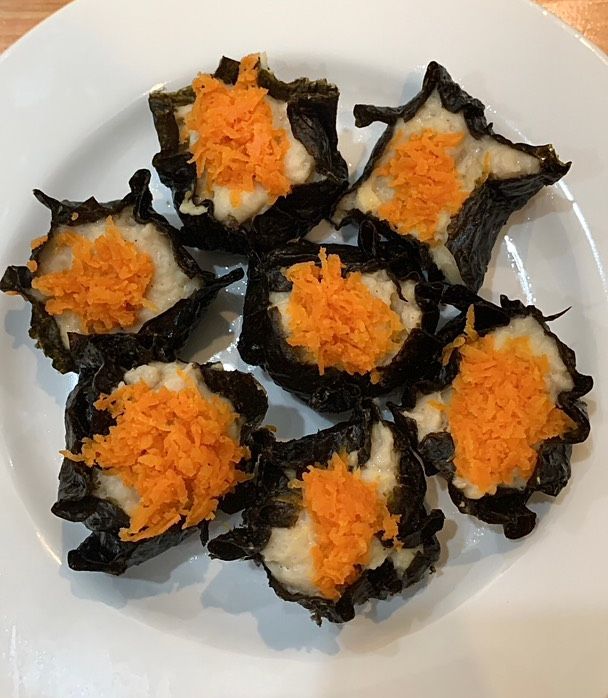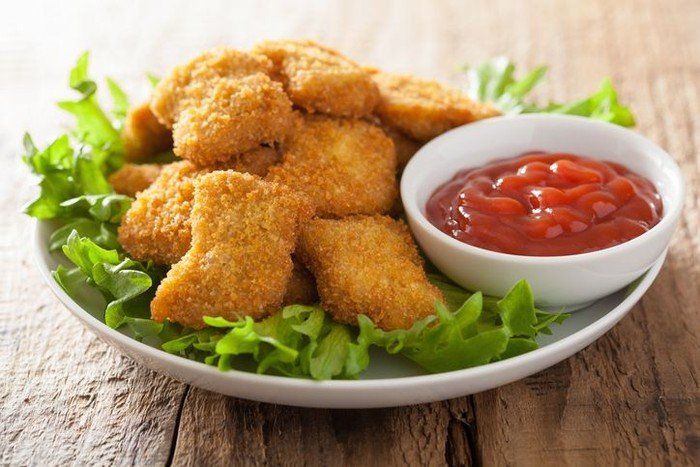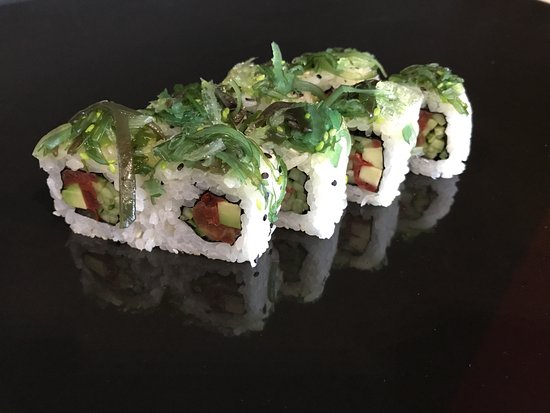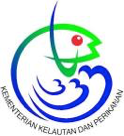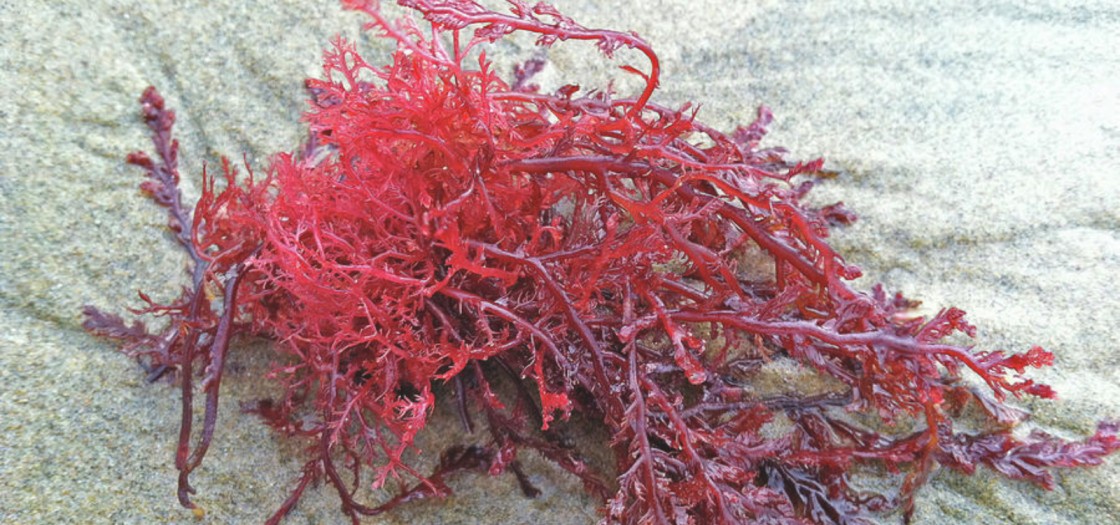
Gracilaria, Graceful Redweed
People eat a lot of seaweed. They just don’t know it. In the industry it is called covert consumption vs overt consumption. What is covert consumption? Did you eat some ice cream recently? You ate seaweed. Some seaweeds have chemicals that control the stability of liquids. One pound of seaweed extract can stabilize a ton ice cream. Look on the label, it’s there, either as agar or carrageenan.
Overt consumption is not consuming an extract but the weed itself. One seaweed genus that is used as a table food and an extract is Gracilaria, a red seaweed that’s crunchy like celery with after taste of ocean. Found in most seas Gracilaria tikvahiae (Graceful Redweed, above) in particular is common around the water of where I now live, Florida. In fact, it is one of the major seaweeds — with G. confervoides, left — in the brackish lagoon called Indian River, about 50 miles east of here.
Further, the Keys ship G. tikvahiae to Hawaii for covert and overt use. Hawaii’s Gracilaria species, G. parvispora, seems has been over harvested. The commercial use for Gracilaria is to make agar, to thicken liquid-based foods. It’s hard to tell many of the species of Gracilaria apart, and each has its own taste and texture.
Commonly used around the world are G. arcuata, G. blodgettii, G. bursa-pastoris, G. cartilagineum, G. chilensis, G. chirda, G. confervoides, G. coronopifolia, G. crassa, G. Edulid, G. eucheumoides, G. foliifera, G. gracilis G. incurvata, G. lichenoides G. virinioifloia, G. parvispora, G. salicornia, G. sjostedtii, G. taenoides, G. tikvahiae, G. verrucosa, and G. vieillardii.
Gracilaria are bushy or irregularly branched — think red vegetable-like spaghetti with a delicious fragrance. The branches can be compressed, flattened, but are usually cylindrical. It is like cartilage when fresh, hard when dry — think coarse, dark hair.
They range from light pink to purplish, sometimes yellowish. Gracilaria are usually found on rock and broken coral in a meter of water or so, in the littoral region, which is from the high water mark to the area of the shore permanently submerged. It can also live adrift.
Related topic: Settings Open Access Review Seaweed Components as Potential Modulators of The Gut Microbiota
As a food Gracilaria are very versatile but are traditionally used three ways. Washed and eaten as a salad, raw or boiled, as a thickener or sun-bleached, dried and used later on as a vegetable-based gelatin. Nutritionally, it is high in manganese and has nitrogen, potassium, zinc and vitamins A and B.
In Vietnam the species is collected in March and April, washed in fresh water, then kneaded into slices and dried in the sun. It is also boiled and eaten with fish, or boil, the water allowed to cool then it is sliced into cubes and sweetened with a sprinkle of sugar.
It can also be washed and then pressed by hand into a gelatin-like mass that is eaten as a kind of pickle/relish or as “dabbo dabbo” which is a sauce of lemon juice and ginger. In Sri Lanka it is made into a soup, pudding or jelly.
The most popular preparation is a porridge made by washing the dried seaweed several times and cooking it in water for 15-20 minutes. The thick soup is strained, coconut cream and lime are added to taste. The commercial recipe is 4.5 pounds seaweed, three limes and 21.5 ounces sugar and 7.5 quarts of water.
In Sri Lanka G. lichenoides is eaten raw or cooked often with salt and tomatoes. That is done with fresh Gracilaria or after dipping it in boiling water. It is also served with onions and vinegar. For use later It is dried without washing. When wanted it is soaked for a day, cleaned, chopped into small pieces and eaten.
To make agar, rinse the Gracilaria in fresh water five or six time until it has lost its pink color. Then take one part washed seaweed to 50 parts water and boil gently with on or two teaspoons of white vinegar until the liquid is thick and opaque. Strain it and let it set. When cool, cut into cubes.
Some like to add sugar and or fruit juice to the liquid before it jells. Another option is after it jells you can cut it into small pieces and mix with soy sauce, vinegar, garlic juice, salted vegetables, sesame oil, coriander and other spices of your choice. It is served like a salad.
A third method is to stir fry the seaweed for a minute and then simmer at least 30 minute or more with salt, soy sauce, sugar, wine, green onion and ginger. That is then cooled and once set, cut into pieces and served cold. Others way is to cook it was pork, fish or vegetables, stewing it all together. That can be eaten hot or jelled. Gracilaria can also be fried in tempura batter.
Related to seaweed: Seaweed Aquaculture from Historic Trends to Current Innovation
In Hawaii Japanese and Korean cooks wash the Gracilaria, drain, then blanch it. A Miso sauce, or vinegar, or a sugar-soy sauce is used to flavor the seaweed. Gracilaria, Ogo in Japanese, which sells for about $6 a pound raw, is a major source of agar. Agar is not digestible, so it is roughage.
It can be used as a poultice for swollen joints and Gracilaria whole makes a good fertilizer. Locally, G. conferiodes and G. tikvahiae can be found in Florida waters and Indian River Lagoon. They can also be found up the east coast of the United States.
There are many Garcilaria on the west coast including G. confervoides and G. sjostedtii. Always wash your fresh seaweed well. On the beach look for what looks like a sprig of red dill. Gracilaria means slender leaved, or graceful leaved.
According to the Smithsonian Marine Station at Ft. Pierce, FL., G. tikvahiae is a “highly opportunistic species common in estuaries and bays, especially where nutrient loading leads to either seasonal or year-round eutrophication (Peckol and Rivers 1995a, 1995b).
Its morphology is highly variable, with colors ranging from dark green to shades of red and brown; with outer branches that can be either somewhat flattened or cylindrical in shape (Littler and Littler 1989). It can be found in protected, quiescent bays, as well as in high energy coastline habitats.
This species grows free or attached to rocks or other substrate and can reach a height of 30 cm (Littler and Littler 1989). G. tikvahiae grows to depths of approximately 10 m, but is most common at depths less than 1 m.”
Also read: Global Study Sheds Light on the Valuable Benefits of Shellfish and Seaweed Aquaculture
This article was first published by Eattheweeds. The accuracy of the information contained therein is not the responsibility of Seaweednetwork.
